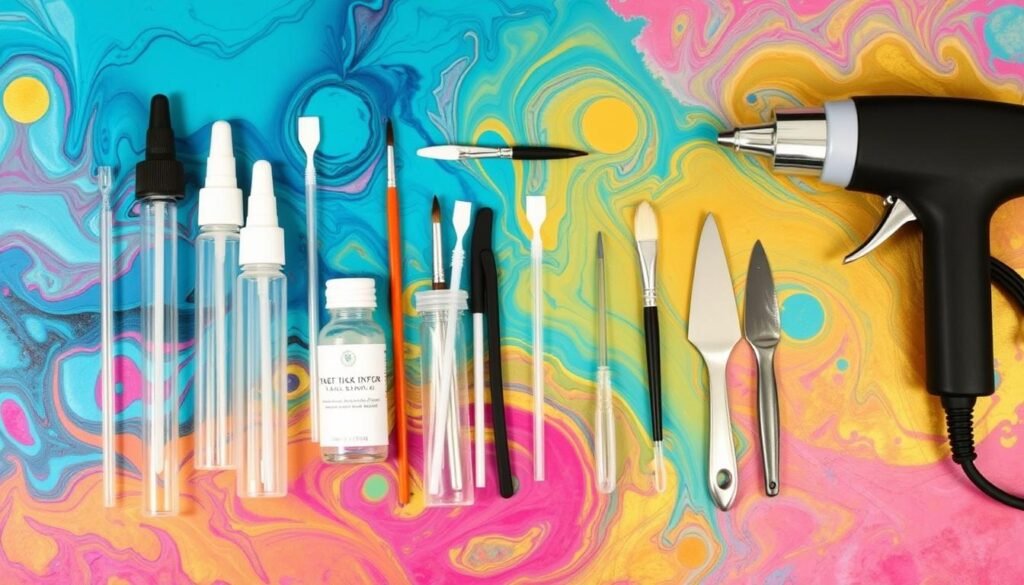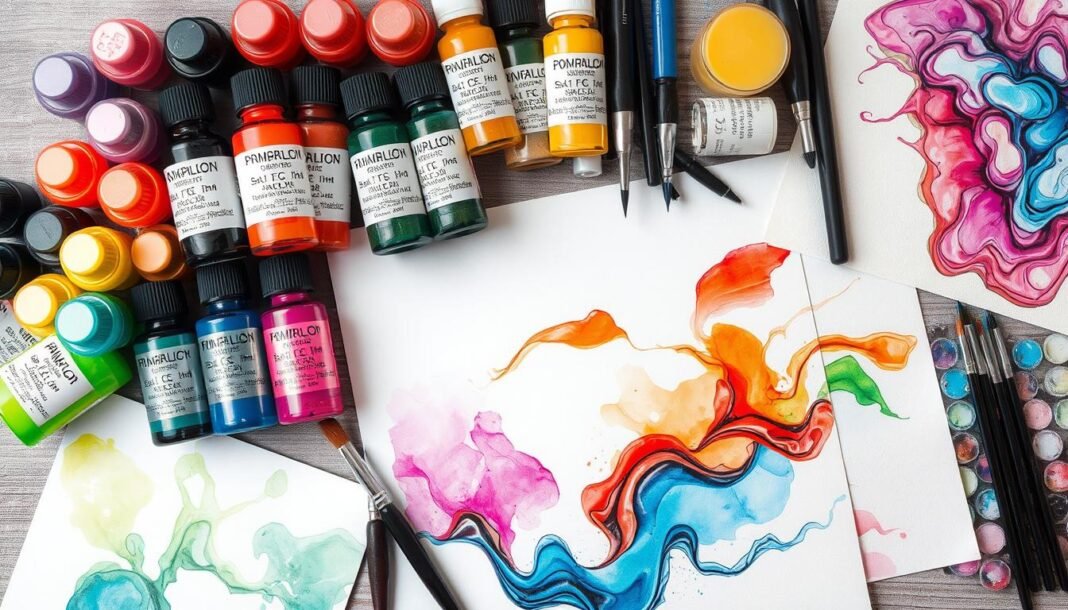Alcohol ink art creates vibrant colors and fluid designs. You only need a few key supplies to start. Let’s look at the essential items for this exciting art form.
High-quality inks, yupo paper, and isopropyl alcohol are vital. These form the base for stunning, flowing artworks. With these basics, you can start developing your unique style.
As you improve, you might want to add more tools. Canned air helps manipulate inks. Waterproof paper is great for practice. Various applicators can create different effects.
Remember, less is often more in alcohol ink art. Start small and build your collection as you grow more comfortable.
Key Takeaways
- High-quality alcohol inks are crucial for vibrant results
- Non-porous surfaces like yupo paper are ideal for alcohol ink art
- Isopropyl alcohol (91% or higher) is essential for blending and effects
- Canned air is safer than breath for moving inks
- Start with basic supplies and expand as you gain experience
- Experiment with various applicators for different effects
- Remember: 50% luck, 50% technique in alcohol ink art
Introduction to Alcohol Ink Art
Alcohol ink art dazzles with bright colors and abstract effects. It uses quick-drying, alcohol-based inks on non-porous surfaces. Artists adore these semi-transparent inks for layering and blending.
The art’s magic comes from its application method. Artists drop ink onto surfaces, then move pigments with alcohol and air. This creates fluid patterns that dry fast, preserving stunning designs.
Popular surfaces for alcohol ink art include:
- Yupo paper
- Ceramic tiles
- Glass
- Metal
- Plastics
Each surface reacts uniquely with the inks. Non-porous materials let inks flow freely. This results in one-of-a-kind abstract effects every time.
“Alcohol ink art is like a dance between pigment and surface, where each movement creates a new masterpiece.”
Safety matters when working with alcohol inks. Use well-ventilated areas and wear gloves. Seal finished artwork with varnish or resin.
This protects vibrant colors from fading. It also ensures your art stays beautiful for years to come.
Essential Alcohol Ink Supplies
Alcohol ink art requires a few key supplies to begin. Let’s explore the essentials for your creative journey.
Alcohol Inks
Alcohol inks are the stars of this art form. Ranger, Piñata, and Copic offer vibrant color options. T-Rex Inks provides 36 colors in three sets: Starter Colors, Warm Tones, and Cool Tones.
This variety allows artists to create stunning effects. You can blend unique hues and explore endless possibilities.
Non-Porous Surfaces
Alcohol inks work best on non-porous surfaces. Yupo paper is popular, offering a smooth, synthetic canvas perfect for ink flow. Ceramic tiles provide a sturdy base for your artwork.
Other suitable surfaces include glass, metal, and acrylic sheets. These materials allow the ink to move freely and create beautiful effects.
Isopropyl Alcohol
91% isopropyl alcohol is crucial for blending and diluting inks. It helps create fluid effects and clean your workspace. Some artists prefer blending solutions to maintain glossiness and extend drying time.
Blending Tools
Experiment with various tools to move and manipulate inks. Cotton swabs, felt applicators, and paintbrushes offer different textures. Try using canned air or a hair dryer with low heat settings for unique effects.
Don’t forget protective gloves for hand blending! Safety is important when working with alcohol inks.
| Supply | Purpose | Popular Brands |
|---|---|---|
| Alcohol Inks | Create vibrant artwork | Ranger, Piñata, Copic |
| Yupo Paper | Non-porous surface for ink flow | Beyond Inks, Nara Papers |
| Ceramic Tiles | Sturdy base for artwork | Various |
| Isopropyl Alcohol | Blending and diluting inks | Any 91% or higher |
Choosing the Right Alcohol Inks
Perfect alcohol inks are vital for your art. Start with primary colors for versatile options. Top brands offer unique properties for different styles.
Ranger by Tim Holtz has color-changing inks when diluted. Their 15 ml bottles have precision tips for controlled flow. Piñata by Jacquard offers concentrated, true-to-color inks.
Beginners can try Piñata’s Exciter Pack or Color Overtones Exciter Pack. T-Rex Inks offers 36 colors in three sets. Their jumbo 20ml bottles give 33% more ink.
Brea Reese sells 20ml bottles at moderate prices. They’re available individually or in packs of three. Copic Marker Ink Refills now come in 12 ml bottles.
Copic inks are highly pigmented, creating rich colors on non-porous surfaces. These work well on Yupo paper, glass, and plastic.
| Brand | Bottle Size | Key Features |
|---|---|---|
| Tim Holtz Ranger | 15 ml | Color-changing, precision tips |
| Jacquard Piñata | Varies | Concentrated, true-to-color |
| T-Rex | 20 ml | Jumbo-sized, 36 colors |
| Brea Reese | 20 ml | Moderate prices, individual or packs |
| Copic | 12 ml | Highly pigmented |
Try different brands to find your favorite. Blending solution is key for diluting inks and creating effects. With the right inks, you’ll be ready to create amazing art.
Non-Porous Surfaces: Your Canvas for Creativity
Alcohol ink art thrives on surfaces that resist absorption. Artists use various non-porous materials as their canvas. Each material offers unique possibilities for creative expression.
Yupo Paper
Synthetic paper, like Yupo, is popular among alcohol ink artists. This water-resistant material lets ink flow freely, creating stunning effects. A Yupo paper pad costs between $10 and $30.
Ceramic Tiles
Glazed tiles provide a smooth, non-porous surface for alcohol ink art. They’re reusable and cost-effective, making them perfect for practice. Many artists recommend starting with tiles to reduce waste and expenses.
Other Suitable Surfaces
Art boards, glass, and plastic acrylic blanks also work well as canvases. These materials offer smooth surfaces that allow more design freedom. Try different surfaces to discover unique effects!
Safety is crucial when working with alcohol inks. Always create in a well-ventilated area. Use gloves to protect your hands from staining.
Blending Solutions and Isopropyl Alcohol
Blending solutions and isopropyl alcohol are vital in alcohol ink art. They help dilute ink and create unique effects. Blending solutions contain alcohol and chemicals for smoother blending, while isopropyl alcohol is cheaper but less silky.
Artists use blending solutions for soft, billowy effects and custom colors. A few drops of colored ink in blending solution can make beautiful custom blends. Isopropyl alcohol works best for quick-drying projects or fabric dyeing.
Isopropyl alcohol dries faster than blending solutions, affecting ink manipulation. For effective blending, use at least 90% isopropyl alcohol. Some artists make DIY solutions by mixing rubbing alcohol with liquid glycerin.
| Aspect | Blending Solution | Isopropyl Alcohol |
|---|---|---|
| Texture | Silky, smooth | Less smooth |
| Evaporation | Slower | Faster |
| Cost | Higher | Lower |
| Fumes | Less fumey | More fumey |
| Best for | Soft effects, custom colors | Quick drying, dilution |
Try different blending methods for exciting results in your alcohol ink art. Use brushes to control ink pooling and add texture. Blow through a straw for rapid, splashy movements.
Your choice between blending solution and isopropyl alcohol can greatly affect your artwork’s final look. Experiment to find the perfect technique for your creative vision.
Tools for Moving and Manipulating Inks
Alcohol ink artists use various tools to create stunning effects. These tools help move and manipulate inks. They allow for precise control and unique textures in artwork.
Air Sources
Hairdryers are popular for moving inks across surfaces. They create flow patterns and dry layers quickly.
Airbrushes offer finer control, ideal for detailed work. Small air blowers provide gentle ink movement.
Brushes and Applicators
Felt applicators blend colors and create smooth transitions. Synthetic brushes work well for precise strokes and details.
Cotton swabs offer versatility for both broad and fine applications.
Droppers and Pipettes
Precision bottles with needle tips allow for exact ink placement. Droppers help mix custom colors and apply small amounts of ink.

| Tool | Use | Effect |
|---|---|---|
| Hairdryer | Moving ink | Flowing patterns |
| Felt applicators | Blending | Smooth transitions |
| Precision bottles | Ink placement | Exact details |
These tools boost creativity in alcohol ink art. Try different combinations to find unique effects. Develop your personal style through experimentation.
What supplies are needed to do alcohol ink art
Alcohol ink art requires specific materials. You’ll need alcohol inks, a non-porous surface, and blending solutions. Alcohol inks come in vibrant colors from brands like Ranger, Pinata, and Copic.
Yupo paper is a top choice for surfaces. It offers a smooth, waterproof canvas for your creations.
Beginners should use isopropyl alcohol (91% or higher) for blending. Yupo paper is ideal for starting out. Ceramic tiles or primed wooden boards work well too.
To explore techniques, you’ll need tools for ink manipulation. These include:
- Straws or air blowers for directing ink flow
- Brushes for detailed work
- Droppers for precise application
- Felt applicators for blending
Safety is key when working with alcohol inks. Use a well-ventilated area or wear a breathing mask. Protect your hands with disposable gloves to avoid stains.
With these supplies, you’re set to create stunning alcohol ink art!
Safety Equipment for Alcohol Ink Artists
Alcohol ink art requires careful attention to safety. Protective gear and workspace ventilation are crucial for a healthy creative experience. Artists must prioritize these safety measures.
Protective Gear
Safety is paramount when working with alcohol inks. A respirator mask with organic vapor cartridges protects against harmful fumes. Nitrile gloves prevent skin contact with inks and solvents.
Other essential safety items include a protective apron or old clothes and safety goggles. These items shield your body and eyes from potential splashes or spills.
- Respirator mask with organic vapor cartridges
- Nitrile gloves
- Protective apron or old clothes
- Safety goggles
Workspace Ventilation
A well-ventilated area is crucial for alcohol ink art. Set up near an open window or use a fan to circulate air. Working outdoors or in a dedicated studio with proper ventilation is ideal.
| Ventilation Method | Effectiveness | Cost |
|---|---|---|
| Open windows | Moderate | Free |
| Portable fan | Good | Low |
| Dedicated ventilation system | Excellent | High |
Safety is not optional in alcohol ink art. Invest in quality protective gear and ensure proper ventilation. These steps will help you enjoy your artistic journey safely and comfortably.
Additional Accessories to Enhance Your Art
Elevate your alcohol ink art with exciting accessories. Masking fluid creates captivating negative space effects. Metallic inks add shimmer to your creations.
Experiment with texturizing materials like wax paper or aluminum foil. These can create unique patterns in your artwork.
The Tim Holtz Alcohol Ink Tool Set includes a Mini Mister and three fine detail brushes. It’s perfect for precise application.
For larger areas, try the Alcohol Ink Mini Applicator Tool. It’s priced at $6.99.
Get creative with everyday items:
- Toothbrushes for splattering effects
- Old credit cards for spreading inks
- Tissue paper for delicate textures
- Q-Tips for blending and detailing
Protect your work with a light coat of protectant spray. This can preserve your designs on ceramic tiles.
For cleanup, use alcohol swabs or the Archival Ink Cleaner ($5.99). These will keep your tools in top shape.
Art is not what you see, but what you make others see.
| Accessory | Price | Reviews |
|---|---|---|
| Acrylic Stamping Block | $4.99 | 4 |
| Craft Scraper | $0.50 | 52 |
| Dina Wakley Media Brushes | $11.99 | 16 |

These tools and techniques open up new possibilities. Explore and enjoy your alcohol ink art journey!
Organizing and Storing Your Alcohol Ink Supplies
Good ink storage and workspace setup are vital for alcohol ink art. Proper supply management lets you focus on creating, not searching. Let’s explore ways to keep your artistic space neat and efficient.
Storage Solutions
Ink storage can be tricky as your collection grows. The Tim Holtz® Alcohol Ink Storage Tin is popular, holding up to 30 Ranger ink bottles. For Copic Various Ink refills, try lipstick holders that store 24 inks each.
One artist manages over 150 ink bottles in their studio. This shows that with the right system, you can organize any collection size.
Workspace Setup
A dedicated workspace improves your artistic flow. Set up an area with easy supply access and good airflow. Use protective coverings on your work surface to prevent stains.
Keep blending solutions within reach. Some artists buy up to 20 bottles at once. Have rubbing alcohol, brushes, and paper towels handy for quick clean-ups.
A well-organized space boosts creativity and protects your supplies. Store inks upright to prevent leaks. Use plastic palettes for mixing colors.
Invest in quality storage cases for your growing collection. With these tips, you’ll create a smooth setup for joyful artistic sessions.


